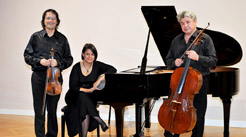Amael Piano Trio, in Review
Amael Piano Trio, in Review Tatjana Ognjanovic, piano Volodja Balzalorsky, violin Damir Hamidullin, cello Weill Recital Hall at Carnegie Hall, New York, NY November 13, 2010A top-notch ensemble, the Amael Piano Trio, was presented this weekend under the auspices of the Spectrum Chamber Music Society, with the support of the Ministry of Culture of the Republic of Slovenia. In a program of 20th-century Slovenian music (first half) and Beethoven’s Piano Trio in B-flat, Op. 97, the “Archduke” (second half), they brought unity and vigor to both old and new.
The Amael Trio, based in Ljubljana, states in its biography (in addition to mentioning traditional repertoire) that it is “dedicated to performing contemporary works, and to the promotion, internationally, of Slovenian composers of piano trio literature.” They did an excellent job of just that in their Saturday evening program, and though only the pianist and violinist are natives of Slovenia (the cellist hailing from Russia), they represented Slovenia with honor. They might add to their biography that they also promote some non-trio works, as there was a violin solo included on their program; considering that each of the three players is of such strong individual ability, they might want to incorporate some solos or duos by the pianist and cellist as well. It would be a welcome addition.
The concert opened in an intensely dark vein with “Maestoso Lugubre” by Lucijan Marija Skerjanc (1900-1973). Composed in 1935, the work is actually the last movement of this composer’s Piano Trio, though Skerjanc himself suggested that it be performed as a single work. From the very first solo cello notes by Damir Hamidullin, a somber lyricism pervaded, deepened by each player’s entry. The synchronization was marvelous, particularly in the string doublings (which can so easily sound “off” but were never so). All three blended in a way that was rich and warm, but also translucent, like the sonic equivalent of amber. The pianist, Tatjana Ognjanovic, managed to be the perfect foundation and “glue” for the trio without any suggestion of dominance even with the Steinway lid up.
Violinist Volodja Balzalorsky came onstage next as soloist in “Something Wild” by Nenad First (b. 1964). Mr. First, though born in Zagreb, lives and works in Slovenia. “Something Wild” is pretty much what its title suggests, a rhapsodic, virtuoso violin showpiece with a rough, rustic streak (plenty of fifths) and dizzying speed (think Bartok meets Paganini). Seemingly fiendishly difficult in parts, it was the compulsory violin work in the 2005 International Johannes Brahms Competition. While I cannot profess to love the piece, it was an intriguing break from the trios and certainly an opportunity for Mr. Balzalorsky to shine.
The first half concluded with the trio performing “Five Short Pieces” by Milko Lazar (b. 1965). Dedicated to the trio in 2001, it is a work of great variety within concise, classically restrained movements, each contrasting with the last (arranged as fast, slow, fast, slow, fast). The performance was one of extreme precision, and it would be hard to imagine it being played more convincingly than it was by this tightly knit ensemble.
Beethoven’s “Archduke” Trio, a masterpiece that is reason enough to go to any concert, was given a fine, mostly polished performance for the evening’s close. Performers are unfortunately subject to the accumulated preferences of a listener when performing such an established masterpiece, and I felt it was slightly unsettled in parts. Occasionally it was a matter of simply needing more agogic placement of downbeats (as in the first movement’s initial move to G major, where a more settled metric feeling can enhance ensuing rhythmic surprises), but other times (as in the magnificent third movement) it seemed that the pursuit of momentum was undermining the overarching grandeur of the work. All in all, though, it was a fulfilling musical evening, and this is a superb ensemble, which I hope to hear again.

